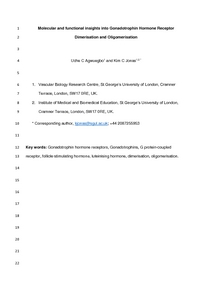Agwuegbo, U; Jonas, KC
(2018)
Molecular and functional insights into gonadotropin hormone receptor dimerization and oligomerization.
Minerva Ginecologica, 70 (5).
pp. 539-548.
ISSN 0026-4784
https://doi.org/10.23736/S0026-4784.18.04287-9
SGUL Authors: Jonas, Kim Carol
![[img]](https://openaccess.sgul.ac.uk/110153/1.hassmallThumbnailVersion/Minerva%20G%20Review_FINAL.pdf)  Preview |
|
PDF
Accepted Version
Available under License ["licenses_description_publisher" not defined].
Download (603kB)
| Preview
|
Abstract
The gonadotrophin hormones, follicle stimulating hormone and luteinising hormone, are essential for reproduction. They work in concert to control multiple aspects of gonadal function to ultimately produce meiotically competent and fertilisable gametes, provide the optimal endometrial environment and support for implantation and maintain pregnancy via progesterone production throughout the first trimester of pregnancy. These complex and multidimensional functions are mediated via the gonadotrophin hormone receptors, luteinising hormone receptor (LHR) and follicle stimulating hormone receptor (FSHR), Class A G protein-coupled receptors (GPCR), which couple to multiple G protein-dependent and independent signal pathways to control these physiological processes. Over the last two decades, a plethora of experimental evidence has shown that GPCRs can associate to form dimers and oligomers. This association provides a means of mediating the diverse functional requirements of a single receptor subtype and for the gonadotrophin hormone receptors, has been shown to alter the pharmacology and signal activation profile of these receptors. This review will detail the historical and current evidence detailing the formation of gonadotrophin hormone receptor homomers and heteromers. We will discuss the functional insight gained from in vitro and in vivo studies, and the potential impact in modulating reproductive health and disease.
Statistics
Item downloaded times since 17 Sep 2018.
Actions (login required)
 |
Edit Item |


